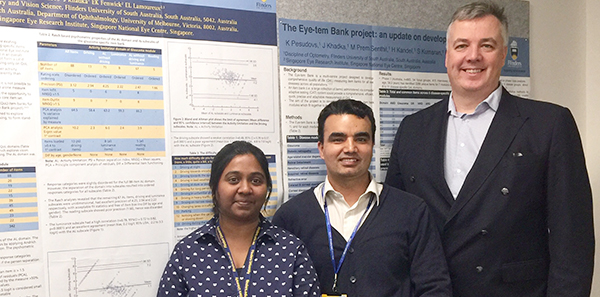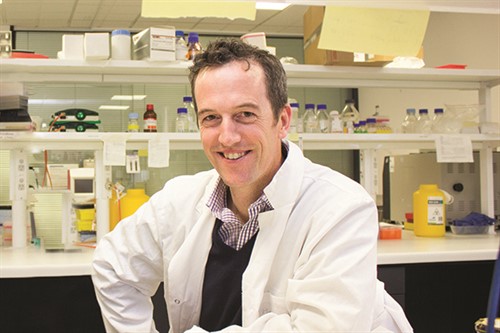1:30min

(L-R) Sheela Kumaran, Dr Jyoti Khadka and Professor Konrad Pesudovs Photo: Flinders University
______________________________
By Helen Carter
Journalist
Amblyopia and strabismus patients required
Optometrists and ophthalmologists are asked to encourage 300 adult patients with amblyopia or strabismus to complete an online survey analysing the impact of the conditions on their quality of life.
Sheela Kumaran, who is undertaking her PhD in the Discipline of Optometry, Flinders University under the supervision of Professor Konrad Pesudovs and Dr Jyoti Khadka, said there was a lack of high-quality evidence about the quality of life impact of these conditions, and the impact of new and old treatments from the perspectives and experiences of patients.
The conditions can pose limitations and inconveniences in driving, playing sport and navigation, affect psychological and emotional well-being, and impact work life and financial prosperity.
Patients must be aged over 18 years and give their consent. Clinicians provide some clinical history with patient consent. Contact Sheela on 0448 326 022 or sheelaopto@gmail.com.
The survey is available at https://www.surveymonkey.com/r/ASQoLsurvey
Contact lenses safe for children
A new review suggests soft contact lenses can be safely prescribed for children and adolescents, with no increase in adverse effects compared to adults.
Dr Mark Bullimore from the University of Houston reviewed nine studies in 1,800 children and adolescents who wore the lenses. He found the incidence of corneal infiltrative events in children was no higher than in adults and may be markedly lower in pre-teen children.
Myopia contact lenses effective
CooperVision says its three-year data on its myopia control contact lenses shows the therapy ‘substantially slows myopia progression and eye elongation as measured by refractive error and axial length.’
The company released data from its clinical evaluation of a dual-focus myopia control one day soft contact lens study, at the British Contact Lens Association clinical conference in Liverpool, England on 12 June.
CooperVision senior manager of clinical research Paul Chamberlain said the study in 144 children aged eight to 12 years showed the Dual-Focus Myopia Control 1-Day Soft Contact Lens slowed myopia progression 59 per cent as measured by mean cycloplegic spherical equivalent and 52 per cent as measured by mean elongation of the eye, compared to children in the control group wearing a single vision one-day contact lens.

Dr Thomas Edwards Photo: CERA
CERA tax appeal for retinal disorders
CERA’s donation appeal this year focuses on CERA researcher Dr Thomas Edwards and his work on finding a cure for inherited retinal disorders, the leading cause of blindness in working age adults.
The appeal aims to establish the first Australian clinical gene therapy trial for an inherited retinal disorder.
Dr Edwards, an ophthalmologist at the Royal Victorian Eye and Ear Hospital, has a PhD from the University of Cambridge and received an Oxford Nuffield Medical Fellowship to study at a world-leading centre for gene therapy, the University of Oxford’s Nuffield Laboratory of Ophthalmology.
At Oxford he learned the latest retinal surgery techniques and now wants to combine his clinical and research skills to develop new treatments for incurable inherited eye diseases.
Computer analyses AMD progression
Austrian researchers have developed a computer model that can be used with OCT to analyse which drusen will survive and which will disappear, to provide a marker for AMD progression.
They used artificial intelligence technology to develop the model to calculate the risk of drusen disappearing, a sign that there is a high chance of developing advanced AMD, and when this will happen.
They claim it is a step towards image-guided prediction of AMD progression and a drusen atlas to predict which patients are at greater risk of drusen disappearing.
Rural health strategy needed
The new edition of Australia’s Health Atlas confirms Australia needs a new rural health strategy, according to National Rural Health Alliance CEO David Butt.
He said the seven million Australians living outside major cities experienced worse health outcomes, and that results of the Second Australian Atlas of Healthcare Variation 2017, released on 7 June, were confronting.
It found 10 of the highest hospitalisation rates for diabetes were in remote areas, and the variation in rates of cataract surgery highlights inequity of access, with the rate of cataract surgery hospitalisations for Indigenous Australians 80 per cent of the rate for other Australians.